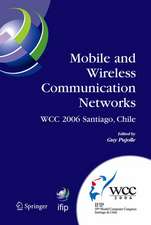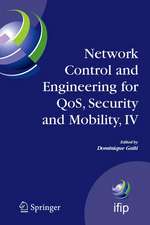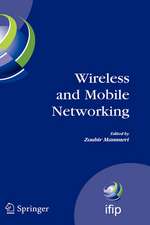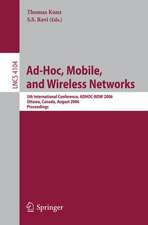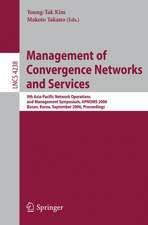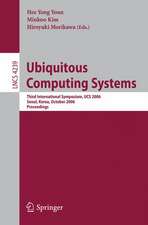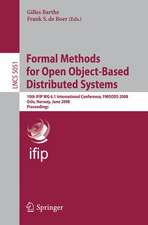Grid Computing: Towards a Global Interconnected Infrastructure: Computer Communications and Networks
Editat de Nikolaos P. Preveen Limba Engleză Paperback – 3 aug 2013
| Toate formatele și edițiile | Preț | Express |
|---|---|---|
| Paperback (1) | 988.66 lei 6-8 săpt. | |
| SPRINGER LONDON – 3 aug 2013 | 988.66 lei 6-8 săpt. | |
| Hardback (1) | 993.28 lei 6-8 săpt. | |
| SPRINGER LONDON – 25 iun 2011 | 993.28 lei 6-8 săpt. |
Din seria Computer Communications and Networks
- 20%
 Preț: 378.18 lei
Preț: 378.18 lei - 20%
 Preț: 684.74 lei
Preț: 684.74 lei - 20%
 Preț: 218.21 lei
Preț: 218.21 lei - 20%
 Preț: 1013.39 lei
Preț: 1013.39 lei - 20%
 Preț: 368.78 lei
Preț: 368.78 lei - 20%
 Preț: 505.48 lei
Preț: 505.48 lei - 20%
 Preț: 646.80 lei
Preț: 646.80 lei - 20%
 Preț: 609.08 lei
Preț: 609.08 lei - 20%
 Preț: 765.60 lei
Preț: 765.60 lei - 20%
 Preț: 339.47 lei
Preț: 339.47 lei - 20%
 Preț: 597.29 lei
Preț: 597.29 lei - 20%
 Preț: 655.85 lei
Preț: 655.85 lei - 20%
 Preț: 997.06 lei
Preț: 997.06 lei - 20%
 Preț: 351.89 lei
Preț: 351.89 lei - 20%
 Preț: 902.00 lei
Preț: 902.00 lei - 20%
 Preț: 996.22 lei
Preț: 996.22 lei - 20%
 Preț: 644.81 lei
Preț: 644.81 lei - 15%
 Preț: 650.69 lei
Preț: 650.69 lei - 20%
 Preț: 650.73 lei
Preț: 650.73 lei - 20%
 Preț: 373.91 lei
Preț: 373.91 lei - 20%
 Preț: 646.95 lei
Preț: 646.95 lei - 20%
 Preț: 1004.99 lei
Preț: 1004.99 lei - 20%
 Preț: 646.80 lei
Preț: 646.80 lei - 20%
 Preț: 341.81 lei
Preț: 341.81 lei - 20%
 Preț: 656.19 lei
Preț: 656.19 lei - 20%
 Preț: 651.75 lei
Preț: 651.75 lei - 20%
 Preț: 331.08 lei
Preț: 331.08 lei - 20%
 Preț: 650.40 lei
Preț: 650.40 lei - 20%
 Preț: 643.97 lei
Preț: 643.97 lei - 20%
 Preț: 761.44 lei
Preț: 761.44 lei - 20%
 Preț: 332.71 lei
Preț: 332.71 lei - 20%
 Preț: 345.59 lei
Preț: 345.59 lei - 20%
 Preț: 332.06 lei
Preț: 332.06 lei - 20%
 Preț: 996.22 lei
Preț: 996.22 lei - 20%
 Preț: 644.15 lei
Preț: 644.15 lei - 20%
 Preț: 326.64 lei
Preț: 326.64 lei - 20%
 Preț: 320.19 lei
Preț: 320.19 lei - 20%
 Preț: 1013.06 lei
Preț: 1013.06 lei - 20%
 Preț: 642.52 lei
Preț: 642.52 lei - 20%
 Preț: 641.01 lei
Preț: 641.01 lei - 20%
 Preț: 718.56 lei
Preț: 718.56 lei - 20%
 Preț: 1043.41 lei
Preț: 1043.41 lei
Preț: 988.66 lei
Preț vechi: 1235.82 lei
-20% Nou
Puncte Express: 1483
Preț estimativ în valută:
189.18€ • 197.52$ • 156.57£
189.18€ • 197.52$ • 156.57£
Carte tipărită la comandă
Livrare economică 05-19 aprilie
Preluare comenzi: 021 569.72.76
Specificații
ISBN-13: 9781447126690
ISBN-10: 1447126696
Pagini: 328
Ilustrații: XVI, 312 p.
Dimensiuni: 155 x 235 x 17 mm
Greutate: 0.46 kg
Ediția:2011
Editura: SPRINGER LONDON
Colecția Springer
Seria Computer Communications and Networks
Locul publicării:London, United Kingdom
ISBN-10: 1447126696
Pagini: 328
Ilustrații: XVI, 312 p.
Dimensiuni: 155 x 235 x 17 mm
Greutate: 0.46 kg
Ediția:2011
Editura: SPRINGER LONDON
Colecția Springer
Seria Computer Communications and Networks
Locul publicării:London, United Kingdom
Public țintă
ResearchCuprins
Part I: E-Science, Applications, & Optimization.- Leveraging the Grid for e-Science.- Supporting e-Science Applications on e-Infrastructure.- GEMS.- Performance Analysis and Optimization of Linear Workflows in Heterogeneous Network Environments.- Part II: Resource Management, Allocation, & Monitoring.- Resource Management and Service Deployment in Grids.- Social Grid Agents.- Monitoring and Controlling Grid Systems.- Part III: Grid Services & Middleware.- Service Level Agreement for Job Control in Grid and High-Performance Computing.- Composable Services Architectures for Grids.- Phoenix.- Part IV: Grid Computing & Scientific Problems.- State-of-art with PhyloGrid.- The Usage of the Grid in the Simulation of the Comet Oort-Cloud Formation.
Recenzii
From the reviews:
“This book on grid computing gathers contributions from a wide range of influential figures in the grid computing environment. … As a reader, I can find a lot of information on grid computing in the public domain. … this book serves as a good repository of articles on theories, architectures, infrastructure administration, and practical applications. Due to this diversity of contributions from successful influencers in grid computing, the book will be well appreciated by academia, researchers, and practitioners.” (Harekrishna Misra, ACM Computing Reviews, July, 2012)
“This book on grid computing gathers contributions from a wide range of influential figures in the grid computing environment. … As a reader, I can find a lot of information on grid computing in the public domain. … this book serves as a good repository of articles on theories, architectures, infrastructure administration, and practical applications. Due to this diversity of contributions from successful influencers in grid computing, the book will be well appreciated by academia, researchers, and practitioners.” (Harekrishna Misra, ACM Computing Reviews, July, 2012)
Textul de pe ultima copertă
Grid computing provides a mechanism for integrating, coordinating, and sharing heterogeneous computer resources. This continually evolving field now aims to completely disaggregate current computer platforms and distribute them across a network as resources that can be called into action by any eligible user or machine at any time.
This accessible and broad-ranging text/reference presents valuable research and results from many of the major projects involved in the emerging global grid infrastructure. With a particular focus on the practical advantages and applications of grid computing – including real case studies – the book provides an in-depth study of grid technology for a wide range of different needs.
Topics and features:
This accessible and broad-ranging text/reference presents valuable research and results from many of the major projects involved in the emerging global grid infrastructure. With a particular focus on the practical advantages and applications of grid computing – including real case studies – the book provides an in-depth study of grid technology for a wide range of different needs.
Topics and features:
- Presents contributions from an international selection of experts in the field
- Provides summarizing abstracts and conclusions for each chapter
- Examines a remote instrumentation infrastructure, and a methodology to support e-science applications on e-infrastructures
- Describes the GEMS storage system, and pipeline workflows for optimizing end-to-end performance in wide-area networks
- Investigates semantic grid system architecture, social grid agents, and monitoring platforms designed for large-scale distributed systems
- Explores job control using service-level agreements
- Introduces the Composable Services Architecture for dynamic service provisioning, and the semantically driven communication middleware platform, Phoenix
- Discusses the PhyloGrid application, and a numerical simulation performed using grid computing
Caracteristici
Provides an in-depth study of grid technology for a wide range of different needs, with a particular focus on the practical advantages and applications of grid computing Presents contributions from an international selection of experts in the field Provides summarizing abstracts and conclusions for each chapter Includes supplementary material: sn.pub/extras


